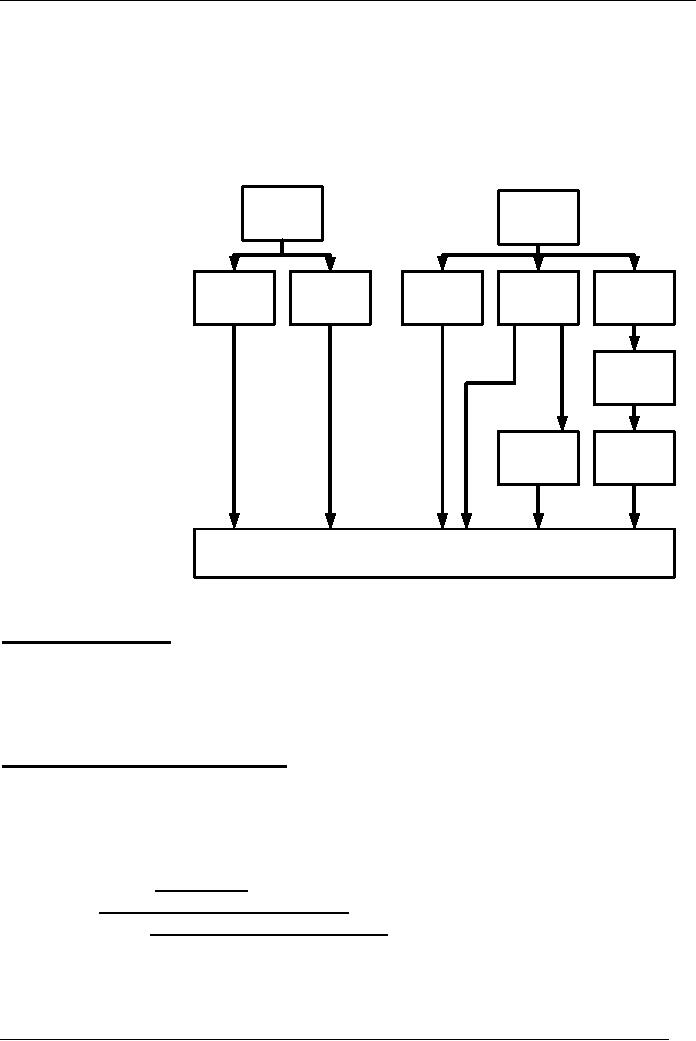 |

Brand
Management (MKT624)
VU
Lesson
29
CHANNELS
OF DISTRIBUTION
The
discussion on two companies having
two different channels
continues. The
graphics
show
that these
companies
have a
Marketing
Channels Company x vs.
Company Y
set
of
mixed
Figure
37
systems
to reach
their
customers.
The
one that is
Company
X
selling
directly is
Company
Y
more
likely to have
improved
margins
(apparently)
than
Mixed
System
Company
-
Direct
Sales
Direct
Sales
Indirect
Sales
the
one
with
Outlets
Direct
and
Indirect
different
systems.
Why
both do not
have
identical
Distributors
systems
is
a
question
of
historical
backgrounds,
sets of
Dealers
Retailers
circumstances,
and
initiatives
their
respective
managements
have
chosen
to take or
CUSTOMERS
not
take at different
points
in time.
Channel
performance
While
assessing the impact on the
three strategic areas
(product-market make-up, sales
revenue,
and
profitability) the objective of
any company should be to
configure its channels in a
way
that
it improves its performance and
offers competitive advantage. The
company with all
direct
customers
seems to be having that advantage, if we
refer to the above
graphics.
Components
of channel performance
Measuring
channel performance, therefore, is
based on three
components1:
1.
Customer reach
2.
Operating efficiency
3.
Service quality
·
If
a company cannot reach its
potential customers, it will not
register sales.
·
If
the cost to reach customers is too high,
then it will adversely affect
profitability.
·
If
customers are not served the
way they want, then
the company cannot retain
them.
To
have a cost-efficient and
customer-effective channel, it is
important that the
three
fundamental
components must work at
satisfactory level. Before we can ensure
that, we must
decide
whether the system should be
direct or indirect, in the
context of those components.
114

Brand
Management (MKT624)
VU
1.
Customer reach - Direct or
Indirect
It
is the determination of the
most optimal level of
cost-efficiency and customer-
effectiveness,
which becomes the basis of
whether you want direct or
indirect channels.
The
channels, in other words,
must save costs and provide
customers value.
Direct
channels include
·
Direct
sales
·
Telemarketing
·
E-marketing
Indirect
channels include intermediaries
like
·
Distributors
·
Wholesalers
·
Retailers
2.
Operating efficiencies
Once
you have decided upon
the method of customer reach
direct or indirect
your
objective
then must be to achieve
operating cost efficiencies.
The costs must not be
high
to
the point of adversely
affecting profits.
Direct
channels offer higher
margins, but then the
responsibility of channel
management
costs rests with the
company.
E-marketing
is fast becoming the norm in
the western markets. It is a
much cheaper way
of
reaching a much bigger
customer base in diverse
areas. The companies that
have
started
e-marketing as a supplement to their
traditional channels are
experiencing higher
levels
of sales, in addition to sales
from stores. Those that started
their business with
e-
marketing
as the core model are not
dependent on any intermediaries.
Indirect
channels offer lower
margins, but then the
channel management costs
are
minimal.
3.
High level of service
quality
Direct
marketing assures a good level of
service because of a direct
interface with the
customer,
but it could be expensive
for maintaining a direct
sales force.
Indirect
marketing removes the
company from customers and,
hence, poses a greater
challenge
of providing good level of
service.
Companies
are dependent upon intermediaries to
offer service to customers, and
they
are
too busy with different
lines of products that they
handle. Also, intermediaries
take
over
the ownership of the product
and control its distribution,
removing the company
away
from controls.
Indirect
marketing therefore has an
inherent disadvantage in not being as
responsive to
customers
as direct marketing.
It
is interesting to note that
within what looks like
direct channels does carry
an indirect
element.
Retailers have started e-marketing
offering delivery to their
customers. This
enhances
their level of service to
their customers. Manufacturers
may not do so for
the
limitation
of items they produce, whereas
retailers having a host of
items from various
companies
are better poised to
directly serve their customers.
What is not to be
overlooked
is the fact that prior to
retailers' direct service to
their customers the
goods
came
from manufacturers, hiding
that part to customers. This
is the element of
indirectness
and a case of B2C channel
system, in which retailers
stock their items
from
different
members of the channel and offer a
service to the end-users of
different
brands.
115

Brand
Management (MKT624)
VU
Channel
system to build value
Whatever
is the system, it has to
ensure fulfillment of customer
needs yet offering
good
profitability
to businesses! In other
words, it must be able to build
customer value
through
either offering enhanced benefits or
lowered costs. This offers
competitive
advantage2.
Value
thru product
benefits
A
channel system must make sure
that product benefits are
offered in the following
forms:
1.
Product quality:
i.
It must deliver the
quality according to the one
promised in the brand
contract
and the one expected by the customer.
Perishable items and cold
items
nowadays are an excellent
example.
You
will not like to buy temperature-abused
ice cream or meat items, nor
will
you be satisfied by a product
with quality compromised on
any account.
ii.
Inventory
management in relation to product ageing
has taken on an added
dimension
within the concept of supply
chain. It forms quality of
service that
the
product must get. Poor
service may result in
expired or near-expiry
items
escaping
system's attention and reaching
retail shelves to the
detriment of
your
brand.
iii.
Regardless
of the system direct or
indirect the company
must be able to
impart
knowledge and training to channel members
and then ensure that
instructions
are being followed for
quality inventory and retail
management.
2.
Product assortment
A
channel must be able to provide
complete range of products all
extensions either
by
form, formats, ingredients,
tastes, flavors, and any
add-on form to achieve
a
desired
level of customer appeal and
product availability. No brand can
afford to be
missed
out of an important retailer; it detracts
customers and, hence,
diminishes the
brand
value. Complete availability is a
must.
Value
thru service
benefits
In
the case a company is
dealing in consumer durables or
industrial products that
require
service
along with the purchase of
the product, then provision
of that service has to be
made
through
the channel. The company
must make sure that the
following factors are built
into
the
channel system:
·
Need
for delivery and
installation
·
Training
·
Technical
support
·
Repair
·
Terms
of payment
·
Credit
·
Easy
return
The
channel system will automatically
offer the following benefits
to the customers:
116

Brand
Management (MKT624)
VU
1.
Transaction services
Customers
must feel the ease
with which the product is
delivered and have
the
assurance
that replacement of faulty parts is
guaranteed. Terms of credit also help
a
great
deal.
2.
After-sales service
This
includes all services that
the company must offer to
keep its customers
satisfied.
Following
are a few examples:
i.
3-S service (sale, service, and
spares) in case of cars and
bikes.
ii.
Installation and repair at your
place of air conditioners.
iii.
Repair and maintenance of
industrial equipment and generators
etc.
Each
of the benefits (product and
service) plays its role. A
company with a better
product may
not
be as successful as its competitor
with an inferior product
only because the company
cannot
meet
the service requirements
that must back the product.
The requirements have to be
met
wherever
those are expected end user or an
intermediary.
The
emergence of company-operated service
centers is an evidence of such a
realization on part
of
the companies. This also reduces
dependence on intermediaries and gives
more seriousness
to
the benefit by showing
company's commitment to
service.
Summary
Depending
on the nature of the
product, the desired reach and
other strategic goals, companies
should
decide whether they would be
better off with a direct
system or an indirect system.
This
question
must also realistically consider a
company's ability to offer
value to its customers.
A
good
channel system builds up
value for customers and at
the same time ensures
profitability
for
the company. Doing the
twin job of serving
customers and the company, a
channel system
can
be termed as the one performing
well. It implies that an
effective channel has a
decent
outreach
that ensures good availability of
the product and it offers
all requisite services to
customers
that meet their expectations. If
the system does not
involve prohibiting costs, it is
efficient.
Such a customer-effective and
cost-efficient system has to be
evolved keeping the
benefits
to customers and value for
the company in mind.
Market
experience of other players is an
authentic guide in making decisions
not meaning
that
you must follow, rather
meaning that you get leads
from what could it be that
they have not
done
so far and if you do will pay
dividends.
Generally,
direct systems have been
found to be expensive, albeit full of
control; indirect
systems
are less expensive, but
offer lower profitability.
Indirect systems generally
support
volume
products. In general, a combination of
different systems is the practice,
for a
combination
offers better coverage of the
market. The better the
coverage, the bigger the
share
of
the market, and higher is
the leveraging of the
brand.
Bibliography:
1.
Roger J. Best: "Market-Based Management
Strategies for Growing Customer
Value
and
Profitability"; Prentice Hall
(273)
2.
Roger J. Best: "Market-Based Management
Strategies for Growing Customer
Value
and
Profitability"; Prentice Hall
(283)
117
Table of Contents:
- UNDERSTANDING BRANDS â INTRODUCTION:Functions of Brand Management, Sales forecast, Brand plan
- INTRODUCTION:Brand Value and Power, Generate Profits and Build Brand Equity
- BRAND MANIFESTATIONS/ FUNDAMENTALS:Brand identity, Communication, Differentiation
- BRAND MANIFESTATIONS/ FUNDAMENTALS:Layers/levels of brands, Commitment of top management
- BRAND CHALLENGES:Consumer Revolt, Media Cost and Fragmentation, Vision
- STRATEGIC BRAND MANAGEMENT:Setting Objectives, Crafting a Strategy, The Brand Mission
- BRAND VISION:Consensus among management, Vision Statement of a Fast Food Company, Glossary of terms
- BUILDING BRAND VISION:Seek senior managementâs input, Determine the financial contribution gap
- BUILDING BRAND VISION:Collect industry data and create a brand vision starter, BRAND PICTURE,
- BRAND PICTURE:Brand Value Pyramid, Importance of being at pinnacle, From pinnacle to bottom
- BRAND PERSONA:Need-based segmentation research, Personality traits through research
- BRAND CONTRACT:The need to stay contemporary, Summary
- BRAND CONTRACT:How to create a brand contract?, Brand contract principles, Understand customersâ perspective
- BRAND CONTRACT:Translate into standards, Fulfill Good Promises, Uncover Bad Promises
- BRAND BASED CUSTOMER MODEL:Identify your competitors, Compare your brand with competition
- BRAND BASED CUSTOMER MODEL:POSITIONING, Product era, Image Era, An important factor
- POSITIONING:Strong Positioning, Understanding of components through an example
- POSITIONING:Clarity about target market, Clarity about point of difference
- POSITIONING â GUIDING PRINCIPLES:Uniqueness, Credibility, Fit
- POSITIONING â GUIDING PRINCIPLES:Communicating the actual positioning, Evaluation criteria, Coining the message
- BRAND EXTENSION:Leveraging, Leveraging, Line Extension in detail, Positive side of line extension
- LINE EXTENSION:Reaction to negative side of extensions, Immediate actions for better managing line extensions
- BRAND EXTENSION/ DIVERSIFICATION:Why extend/diversify the brand,
- POSITIONING â THE BASE OF EXTENSION:Extending your target market, Consistency with brand vision
- DEVELOPING THE MODEL OF BRAND EXTENSION:Limitations, Multi-brand portfolio, The question of portfolio size
- BRAND PORTFOLIO:Segment variance, Constraints, Developing the model â multi-brand portfolio
- BRAND ARCHITECTURE:Branding strategies, Drawbacks of the product brand strategy, The umbrella brand strategy
- BRAND ARCHITECTURE:Source brand strategy, Endorsing brand strategy, What strategy to choose?
- CHANNELS OF DISTRIBUTION:Components of channel performance, Value thru product benefits
- CREATING VALUE:Value thru cost-efficiency, Membersâ relationship with brand, Power defined
- CO BRANDING:Bundling, Forms of communications, Advertising and Promotions
- CUSTOMER RESPONSE HIERARCHY:Brand-based strategy, Methods of appropriations
- ADVERTISING:Developing advertising, Major responsibilities
- ADVERTISING:Message Frequency and Customer Awareness, Message Reinforcement
- SALES PROMOTIONS:Involvement of sales staff, Effects of promotions, Duration should be short
- OTHER COMMUNICATION TOOLS:Public relations, Event marketing, Foundations of one-to-one relationship
- PRICING:Strong umbrella lets you charge premium, Factors that drive loyalty
- PRICING:Market-based pricing, Cost-based pricing
- RETURN ON BRAND INVESTMENT â ROBI:Brand dynamics, On the relevance dimension
- BRAND DYNAMICS:On the dimension of knowledge, The importance of measures
- BRAND â BASED ORGANIZATION:Benefits, Not just marketing but whole culture, Tools to effective communication
- SERVICE BRANDS:The difference, Hard side of service selling, Solutions
- BRAND PLANNING:Corporate strategy and brands, Brand chartering, Brand planning process
- BRAND PLANNING PROCESS:Driver for change (continued), Brand analysis
- BRAND PLAN:Objectives, Need, Source of volume, Media strategy, Management strategy